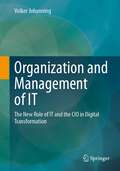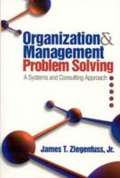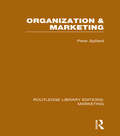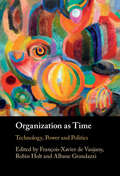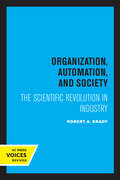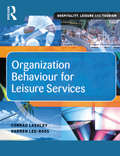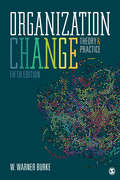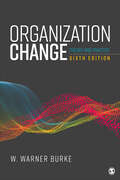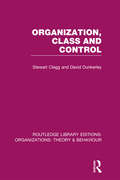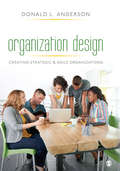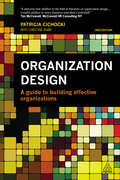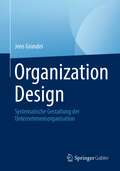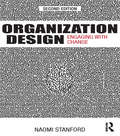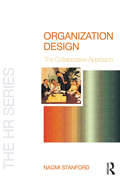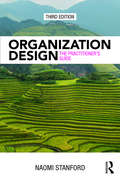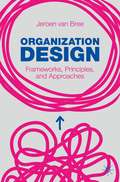- Table View
- List View
Organization and Management of IT: The New Role of IT and the CIO in Digital Transformation
by Volker JohanningThis book takes a practical look at how IT organizations need to position themselves optimally in this dynamically changing world and what this means for the leadership of this increasingly important IT. In addition, the book takes a closer look at the topic of managing an IT organization: What is the role and what are the leadership responsibilities of a CIO? How and by what means can an IT organization best be managed? How can complex change processes and transformations be managed? Thus, the book offers a practical guide for organizational change or reorganization of IT with many tips on change management, leadership, and agile methods and approaches in the new IT organization.
Organization And Management Problem Solving: A Systems And Consulting Approach
by James T. ZiegenfussBased on a broad range of case studies, Organization and Management Problem Solving is an insightful text designed to improve the application of organization theory and systems thinking in teaching and practice. This book illustrates the five key themes in the nature of organization and management--technical, structural, psychosocial, managerial, and cultural--through the analysis of measured incidents tested by students. This book is relevant to consultants, academics, and professional managers in a number of settings (academic, military, business organizations, and research institutes) and disciplines (including development and change, management, human resources, social psychology, communication, sociology, and psychology).
Organization and Marketing (Routledge Library Editions: Marketing)
by Peter SpillardTaking as its starting point the nature of marketing tasks, this book draws on organizational theories and makes its own contribution to generate insights and understanding about some of the concerns that need to be deal with if marketing success is to be achieved. The book surveys developments in the study of organizations, and considers how organizations can be adapted to better serve the needs of marketing.
Organization and Organizing: Materiality, Agency and Discourse
by François Cooren Daniel RobichaudRecipient of the '2013 Top Edited Book Award', by the Organizational Communication Division of the National Communication Association (USA) This timely collection addresses central issues in organizational communication theory on the nature of organizing and organization. The unique strength of this volume is its contribution to the conception of materiality, agency, and discourse in current theorizing and research on the constitution of organizations. It addresses such questions as: To what extent should the materiality of texts and artifacts be accounted for in a process view of organization? What part does materiality play in the process by which organizations achieve continuity in time and space? In what sense do artifacts perform a role in human communication and interaction and in the constitution of organization? What are the voices and entities participating in the emergence and stabilization of organizational reality? The work represents scholarship going on in various parts of the world, and features contributions that overcome traditional conceptions of the nature of organizing by addressing in specific ways the difficult issues of the performative character of agency; materiality as the basis of the iterability of communication and continuity of organizations; and discourse as both textuality and interaction. The contributions laid out in this book also pay tribute to the work of the organizational communication theorist James R. Taylor, who developed a view of organization as deeply rooted in communication and language. Contributors extend and challenge Taylor’s communicative view by tackling issues and assumptions left implicit in his work.
Organization and Strategy at Millennium (A)
by Scott Waggoner Julie M. WulfThis case examines Millennium's strategic and organizational responses to the rapid evolution of the biopharmaceutical industry. In the early 2000s, as Millennium's competitive advantage in early-stage research slipped away and its losses mounted, founder and CEO Mark Levin moved the firm downstream away from research and towards drug development and commercialization, while narrowing horizontal breadth from over a dozen therapeutic classes to just three. In 2005, Levin hired Deborah Dunsire from Novartis as CEO to lead Millennium's continuing transformation. Students are asked to put themselves in the shoes of incoming CEO Dunsire and to provide organizational recommendations to execute the new strategy.
Organization and Strategy at Millennium (B)
by Scott Waggoner Julie M. WulfThis case examines Millennium's strategic and organizational responses to the rapid evolution of the biopharmaceutical industry. In the early 2000s, as Millennium's competitive advantage in early-stage research slipped away and its losses mounted, founder CEO Mark Levin moved the firm downstream away from research and towards drug development and commercialization, while narrowing horizontal breadth from over a dozen therapeutic classes to just three. In 2005, Levin hired Deborah Dunsire from Novartis as CEO to lead Millennium's continuing transformation. Students are asked to put themselves in the shoes of incoming CEO Dunsire and to provide organizational recommendations to execute the new strategy.
Organization as Time: Technology, Power and Politics
by Robin Holt de Vaujany, François-Xavier Albane GrandazziThe bulk of Management and Organization Studies deals with time as organization. Time is performed, organized, enacted, and as such is a locus of power. In this edited book, we stress the importance of organization as time. Time is an organizing force. The happening and becoming of collective activity, its technologies, its images, keep empowering, dominating or (more rarely) emancipating the fragile and ephemeral subjectivities of our world. The turn to digitality in all aspects of contemporary life has made the organizing power of time more pervasive than ever. How to describe organization as time? How to explore the relationship between becoming, duration, images, events, non-events or historicity and their relationships with power and emancipation? These are the rich and varied challenges seized by this book by a team of leading scholars interested in time and temporality in the context of management and organization.
Organization, Automation, and Society: The Scientific Revolution in Industry
by Robert A. BradyThis title is part of UC Press's Voices Revived program, which commemorates University of California Press’s mission to seek out and cultivate the brightest minds and give them voice, reach, and impact. Drawing on a backlist dating to 1893, Voices Revived makes high-quality, peer-reviewed scholarship accessible once again using print-on-demand technology. This title was originally published in 1961.
Organization Behavior Reading: Negotiation
by Max H. Bazerman Francesca Gino Katherine ShonkManagerial, executive, and entrepreneurial success requires the ability to negotiate. The essential reading and recommended module plan will help students to become more effective negotiators by: 1) mastering a negotiation framework that will help them analyze, prepare for, and execute negotiations more systematically-and hence, more effectively-in a wide variety of contexts; 2) building a negotiation toolkit that consists of practical strategies for creating and capturing value in negotiation; and 3) learning how to create a negotiation environment that helps diagnose individual needs, and allows negotiators to identify techniques for mitigating weaknesses and leveraging their strengths. The supplemental reading addresses two additional topics: cross-cultural negotiations and gender issues in negotiation.
Organization Behaviour for Leisure Services
by Darren Lee-Ross Conrad LashleyOrganization Behaviour for Leisure Services provides the reader with the conceptual tools necessary for analysing organizational behaviour in the context of hospitality, leisure and tourism provision, and understaanding events in order to take appropriate management action.Taking the view that leisure services involve an array of industry sectors - they are related, for instance, to work-time spent eating, drinking and staying away from home, as well as the more obvious recreational pursuits - the text uses examples and case studies from a wide range of international businesses such as hotels, restaurants, museums, shopping malls and sports stadia. Specific examples used are from Marriotts, McDonald's, Trafford Centre and many more. With a user-friendly structure and style, the text is an ideal introduction to the fundamental issues involved - perfect for students and managers alike. This book discusses and questions a number of key elements, including: The individual and the organization Groups in the organization Organizational structures and behaviour Management within the organization Commercial hospitality, leisure and tourism in a service context There is a Tutor Resource pack available to lecturers who adopt this text. Accredited lecturers can request access to download this material by going to http://books.elsevier.com/academic/defaultmanuals.asp? to request access.
Organization Capital Readiness
by Robert S. Kaplan David P. NortonTo complement alignment of competencies and technologies, executives must also develop organization capital, defined as the ability of the organization to mobilize and sustain the process of change required to execute the strategy. Organization capital provides the capability for integration so that individual intangible human and information capital assets, as well as tangible physical and financial assets, are not only aligned to the strategy, but are integrated and working together to achieve the organization's strategic objectives. This chapter provides a framework for describing and measuring organization capital.
Organization Change: Theory and Practice
by W. Warner BurkeChange is a constant in today's organizations. Leaders, managers, and employees at all levels must understand both how to implement planned changed and effectively handle unexpected change. The Fifth Edition of the Organization Change: Theory and Practice provides an eye-opening exploration into the nature of change by presenting the latest evidence-based research to discuss a range of theories, models, and perspectives on organization change. Bestselling author, W. Warner Burke, skillfully connects theory to practice with modern cases of effective and ineffective organization change, recent examples of transformational leadership and planned and revolutionary change, and best practices to successfully influence change. This fully-updated new edition also includes a new chapter on healthcare and government organizations, offering practical applications for non-profit organizations.
Organization Change: Theory and Practice
by W. Warner BurkeChange is a constant in today's organizations. Leaders, managers, and employees at all levels must understand both how to implement planned changed and effectively handle unexpected change. The Fifth Edition of the Organization Change: Theory and Practice provides an eye-opening exploration into the nature of change by presenting the latest evidence-based research to discuss a range of theories, models, and perspectives on organization change. Bestselling author, W. Warner Burke, skillfully connects theory to practice with modern cases of effective and ineffective organization change, recent examples of transformational leadership and planned and revolutionary change, and best practices to successfully influence change. This fully-updated new edition also includes a new chapter on healthcare and government organizations, offering practical applications for non-profit organizations.
Organization Change: Theory and Practice
by W. Warner BurkeChange is a constant in today′s organizations. Leaders, managers, and employees must understand how to implement planned change and handle unexpected change. The Sixth Edition of Organization Change: Theory and Practice provides an eye-opening exploration into the nature of change by presenting the latest evidence-based research to discuss a range of theories, models, and perspectives on organizational change. Bestselling author, W. Warner Burke, skillfully connects theory to practice with modern cases of effective and ineffective organizational change, recent examples of transformational leadership and planned and revolutionary change, and best practices to successfully influence change. The fully-updated sixth edition includes a new chapter on current evidence about organization change, including reviews of prescriptive models of planned change, evidence-based principles of change management, the role of an organization′s history as part of the change process, and leaders′ impact on organizational change.
Organization Change: Theory and Practice
by W. Warner BurkeChange is a constant in today′s organizations. Leaders, managers, and employees must understand how to implement planned change and handle unexpected change. The Sixth Edition of Organization Change: Theory and Practice provides an eye-opening exploration into the nature of change by presenting the latest evidence-based research to discuss a range of theories, models, and perspectives on organizational change. Bestselling author, W. Warner Burke, skillfully connects theory to practice with modern cases of effective and ineffective organizational change, recent examples of transformational leadership and planned and revolutionary change, and best practices to successfully influence change. The fully-updated sixth edition includes a new chapter on current evidence about organization change, including reviews of prescriptive models of planned change, evidence-based principles of change management, the role of an organization′s history as part of the change process, and leaders′ impact on organizational change.
Organization, Class and Control (Routledge Library Editions: Organizations)
by Stewart Clegg David DunkerleyIn this volume the authors develop a systematic and chronologically based critique of the major concepts, figures and schools in organization. Themes discussed include: the development of scientific management and the responses of Gramsci and Lenin to it the meaning of Mayo and the Human Relations School the development of typological systems and contingency models of the organization key concepts of goals, environment and technology.
Organization Design: Creating Strategic & Agile Organizations
by Dr Donald L. AndersonTo thrive in today’s rapidly changing, global, dynamic business environment characterized by constant change and disruption, organizations must be able to adapt and innovate to maintain their competitive edge. Organization Design: Creating Strategic & Agile Organizations prepares students to make smart strategic decisions when designing and redesigning organizations. Structured around Galbraith’s Star Model™, the text explores five facets of organization design: strategy, structure, processes, people, and rewards. Author Donald L. Anderson distills contemporary and classic research into practical applications and best practices. Cases, exercises, and a simulation activity provide multiple opportunities for students to practice making design decisions. Includes an innovative organization design simulation activity that puts students in the role of a design practitioner!
Organization Design: Creating Strategic & Agile Organizations
by Dr Donald L. AndersonTo thrive in today’s rapidly changing, global, dynamic business environment characterized by constant change and disruption, organizations must be able to adapt and innovate to maintain their competitive edge. Organization Design: Creating Strategic & Agile Organizations prepares students to make smart strategic decisions when designing and redesigning organizations. Structured around Galbraith’s Star Model™, the text explores five facets of organization design: strategy, structure, processes, people, and rewards. Author Donald L. Anderson distills contemporary and classic research into practical applications and best practices. Cases, exercises, and a simulation activity provide multiple opportunities for students to practice making design decisions. Includes an innovative organization design simulation activity that puts students in the role of a design practitioner!
Organization Design
by Patricia Cichocki Christine IrwinWith the rate of change in organizations at an all-time high, the need for strong organization design has never been more pressing. Organization Design provides a complete road map to design and delivery and covers all the critical areas including downsizing, outsourcing, job design, change management and re-structuring. This thoroughly revised edition is a practical toolkit to take organization designers from start to finish, outlining the basic theory, providing a step-by-step approach to implementation, and offering solutions to the recurring challenges that will inevitably be met along the way.
Organization Design: Systematische Gestaltung der Unternehmensorganisation
by Jens GrundeiDieses Fachbuch bietet einen fundierten Ansatz zur Lösung praktischer Organisationsprobleme, mit denen Manager und Berater häufig konfrontiert werden. Es wird zunächst gezeigt, wie Organisationsfragen als Management-Entscheidungsprobleme verstanden und einer konsequenten Steuerung zugänglich gemacht werden können. An die Eingrenzung des Gegenstands von Reorganisationen schließt sich eine eingehende Erläuterung geeigneter Beurteilungskriterien für Organisationsstrukturen an. Sodann werden die Kernalternativen der organisatorischen Gestaltung erläutert, bevor exemplarisch gezeigt wird, wie sich konkrete Organisationsformen anhand der Kriterien beurteilen lassen. Neue Organisationsformen werden dabei jeweils explizit berücksichtigt. Für die Auswahl einer zweckmäßigen Organisation wird abschließend auf die strategiebasierte Gewichtung von Organisationszielen sowie die Integration der sachlogischen und verhaltensorientierten Beurteilungsperspektive eingegangen. Zahlreiche Praxisbeispiele sowie Definitionen wichtiger Begriffe, Merksätze und Hintergrundinformationen erleichtern die Umsetzung in die Unternehmenspraxis.
Organization Design: Fashion or Fit?
by Henry MintzbergThe characteristics of organizations fall into one of five natural configurations, each a combination of certain elements of structure and situation. The five configurations are the simple structure, machine bureaucracy, professional bureaucracy, divisionalized form, and adhocracy. These five configurations serve as an effective tool in diagnosing the problems of organizational design.
Organization Design: Engaging with Change
by Naomi StanfordAs the purse strings tighten company costs need to be cut without this affecting performance or sales. A common solution to this problem is to restructure the organization of the company i.e. adjust the lines and boxes on the organization chart with the aim of setting it up for high performance. This inevitably fails because an organization is a system; change one aspect and other facets will also change. Organization Design: Engaging with change looks at how to (re) design the organizational system in order to increase productivity, performance and value; providing the knowledge and methodology to design an agile organization capable of handling the kind of continuous organizational change that all businesses face. The book clarifies why and how organizations need to be in a state of readiness to design or redesign and emphasizes that people as well as business processes must be part of design considerations. Responding to developments across the world since the first edition, this book covers, among other topics: Technology changes that have impacted upon organizations Increased demands for ‘sustainability’ and corporate social responsibility The pressure on organizations to be smarter, more efficient and more effective Whilst the material on this subject targets a wide management audience, this book is specifically written for consultants, OD/HR practitioners and line managers working together to achieve the goal of organizational redesign for changing circumstances. Aided by a range of pedagogical features, this book is a must-read for students or practitioners involved in the field of organizational design, development and change.
Organization Design
by Naomi StanfordOrganization Design looks at how you need to change the ways your organization does things in order to increase productivity, performance, and profit. Providing the knowledge and method to handle the kind of recurring organisational change that all businesses face, those which do not involve transforming the entire enterprise but which necessitate significant change at the business unit, divisional, functional, facility or local levels. The problem lies in knowing what needs to change and how to change it. Taking the organisation as a designed system, it describes four major elements of organizations: the work - the basic tasks to be done by the organisation and its parts, the people - characteristics of individuals in the organization, formal organization - structures eg the organisation hierarchy, processes, and methods that are formally created to get individuals to perform tasks, informal organization - emerging arrangements including variations to the norm, processes, and relationships, commonly described as the culture or 'the way we do things round here'. The way these four elements relate, combine and interact affects productivity, performance and profit. Most books on this subject target a wide management audience rather than HR, this is specifically written for HR practitioners and line managers working together to achieve the goal. It clarifies why and how organisations need to be in a state of readiness to design or redesign and emphasises that people as well as business processes must be part of design considerations.
Organization Design: The Practitioner’s Guide
by Naomi StanfordOrganization Design looks at how to (re)design an organizational system in order to increase productivity, performance and value, and provides the knowledge and methodology to design an adaptive, agile organization capable of handling the kind of continuous organizational change that all businesses face. The book clarifies why and how organizations need to be in a state of readiness to design or redesign, and emphasizes that people as well as business processes must be part of design considerations. With an enhanced international focus, this third edition includes new material on: organization design theories designing ethical, diverse and inclusive organizations the role of leaders in organization design work organization design in public sector organizations and evaluating the success of an organization design project Aided by a range of pedagogical features and downloadable resources, this book is a must-read for students or practitioners involved in organizational design, development and change.
Organization Design: Frameworks, Principles, and Approaches
by Jeroen van BreeThis upper-level textbook provides a practical guide to the field of organization design, grounded in academic literature. It is set apart from other books on the topic by its commitment to be relevant to Master’s students, as well as practitioners looking for evidence-based guidance. The book provides a solid theoretical background for students, defining what organization design is, exploring the history of the field, and describing established frameworks and theories. It then investigates why organizations may seek to embark on a re-design, and what a well-designed organization looks like, referencing case studies and the author’s own research. From there, it takes students through how organization design occurs, examining various models for intervention, the core steps in designing an organization, and what challenges a practitioner may face, all illustrated by stories from the field. This book includes a wide range of didactic elements for students, including learning objectives, case study examples, review questions, and further reading. It examines the impact of new ways of organizing, and draws on the author’s years of experience as a consultant to ensure that academic theory is seamlessly melded with practical application.
